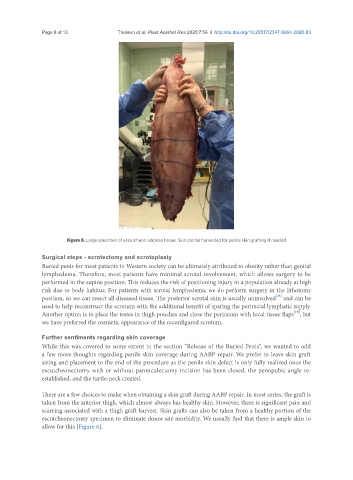Page 652 - Read Online
P. 652
Page 8 of 13 Theisen et al. Plast Aesthet Res 2020;7:56 I http://dx.doi.org/10.20517/2347-9264.2020.83
Figure 8. Large specimen of escutcheon adipose tissue. Skin can be harvested for penile skin grafting if needed
Surgical steps - scrotectomy and scrotoplasty
Buried penis for most patients in Western society can be ultimately attributed to obesity rather than genital
lymphedema. Therefore, most patients have minimal scrotal involvement, which allows surgery to be
performed in the supine position. This reduces the risk of positioning injury in a population already at high
risk due to body habitus. For patients with scrotal lymphedema, we do perform surgery in the lithotomy
[28]
position, so we can resect all diseased tissue. The posterior scrotal skin is usually uninvolved and can be
used to help reconstruct the scrotum with the additional benefit of sparing the perirectal lymphatic supply.
[15]
Another option is to place the testes in thigh pouches and close the perineum with local tissue flaps , but
we have preferred the cosmetic appearance of the reconfigured scrotum.
Further sentiments regarding skin coverage
While this was covered to some extent in the section “Release of the Buried Penis”, we wanted to add
a few more thoughts regarding penile skin coverage during AABP repair. We prefer to leave skin graft
sizing and placement to the end of the procedure as the penile skin defect is only fully realized once the
escutcheonectomy with or without panniculectomy incision has been closed, the penopubic angle re-
established, and the turtle-neck created.
There are a few choices to make when obtaining a skin graft during AABP repair. In most series, the graft is
taken from the anterior thigh, which almost always has healthy skin. However, there is significant pain and
scarring associated with a thigh graft harvest. Skin grafts can also be taken from a healthy portion of the
escutcheonectomy specimen to eliminate donor site morbidity. We usually find that there is ample skin to
allow for this [Figure 8].

